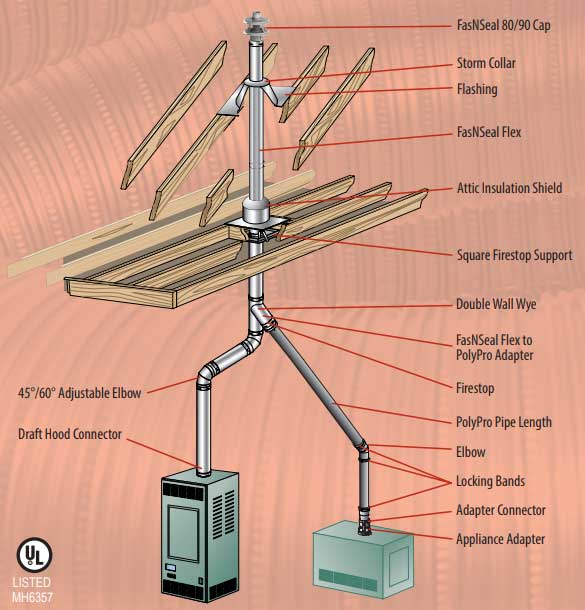We are going to be upgrading our furnace to a new 95% HVAC system and still have a traditional hot water heater. i am hoping that we can find an insert for our 7" vent pipe going through the roof that can do both hot gas (HWH) and the new 95% HVAC venting. Or am i crazy? Thanks
Not that you asked, but furnace replacement is an opportunity moment to right-size the system, a once in every 15-30 years type of event. Almost all furnaces in the US are 3x or more oversized, which has a NEGATIVE affect on comfort, and at some oversize factor it even makes it impossible to fully heat rooms at the ends of the runs. It's shocking how many homes with 30,000 BTU/hr design loads are fitted with furnaces with output >100,000 BTU/hr. In some areas it's practically the norm. ASHRAE recommends an oversize factor of only 1.4x, which is enough to have a high, comfortable duty cycle during normal cold weather and be able to utilize overnight setbacks, and even enough to reasonably cover most Polar Vortex disturbance cold snaps. Instead of a noisy blast of high cfm hot-flash followed by the extended drafty cool, at 1.4x oversizing it's running (1/1.4=) 71% of the time when it's at the
99% outside design temperature with a lower velocity warm summer breeze effect.
To get a handle on the right size, run a
fuel-use heat load calculation, which uses the old furnace as a measuring instrument. This type of measurement also automatically factors in duct losses, etc (since those can't actually be factored out.) It's important to use wintertime fuel use numbers only, which minimizes the error from hot water/cooking/other uses of the same fuel, as well as the error from solar gains. (The other-uses error an solar gain error tend to cancel each other out in winter, but not perfectly.) If it's replacing a 3x oversized furnace upsizing by no more than 1.4x from the calculated 99% load the house will be noticeably more comfortable in winter, even during milder normal-cold weather, and MUCH more comfortable during cold snaps. It may seem to the uninitiated that it's "struggling to keep up" during cold snaps, but that is a mis-perception created by the experience of having lived with grossly oversized equipment.
Regarding the venting- a typical~80% combustion efficiency gas water heater can't share a vent with a condensing furnace. If you're keeping the water heater, install
a narrowing flue liner inside the existing vent that is sized for the BTU output of just the water heater (3" for most water heaters, sometimes 4" for bigger-BTU tank type water heaters).
Venting a water heater into a 7" vent would result in a
high potential for backdrafting exhaust into the house, and creates considerable acidic exhaust condensation inside the vent &/or chimney causing it to
fail in short years.
If it's a power-drafted water heater it may be possible to use separate 2" plastic venting using the old 7" vent as a flue chase for both the new furnace vent (separate from the water heater's vent) and the water heater, depending on the geometry.
It's pretty common and often easier to side-vent condensing furnaces out the side of the house. Just be sure the air intake and exhaust are on the same side of the house, sufficiently far apart to avoid cross contamination, and observe clearances to operable windows or ventilation air intakes. It's also important to keep both the air intake and exhaust terminations above the local snow drift lines, often achievable with a "snorkel" type arrangement.


